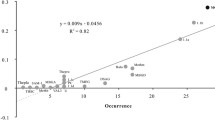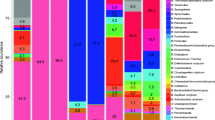Abstract
The diversity of archaea and bacteria was investigated in ten hot springs (elevation >4600 m above sea level) in Central and Central-Eastern Tibet using 16S rRNA gene phylogenetic analysis. The temperature and pH of these hot springs were 26–81°C and close to neutral, respectively. A total of 959 (415 and 544 for bacteria and archaea, respectively) clone sequences were obtained. Phylogenetic analysis showed that bacteria were more diverse than archaea and that these clone sequences were classified into 82 bacterial and 41 archaeal operational taxonomic units (OTUs), respectively. The retrieved bacterial clones were mainly affiliated with four known groups (i.e., Firmicutes, Proteobacteria, Cyanobacteria, Chloroflexi), which were similar to those in other neutral-pH hot springs at low elevations. In contrast, most of the archaeal clones from the Tibetan hot springs were affiliated with Thaumarchaeota, a newly proposed archaeal phylum. The dominance of Thaumarchaeota in the archaeal community of the Tibetan hot springs appears to be unique, although the exact reasons are not yet known. Statistical analysis showed that diversity indices of both archaea and bacteria were not statistically correlated with temperature, which is consistent with previous studies.






Similar content being viewed by others
References
Aditiawati P, Yohandini H, Madayanti F, Akhmaloka (2009) Microbial diversity of acidic hot spring (kawah hujan B) in geothermal field of kamojang area, west Java-Indonesia. Open Microbiol J 3:58–66
Aguilera A, Souza-Egipsy V, Gonzalez-Toril E, Rendueles O, Amils R (2010) Eukaryotic microbial diversity of phototrophic microbial mats in two Icelandic geothermal hot springs. Int Microbiol 13:21–32
Allewalt JP, Bateson MM, Revsbech NP, Slack K, Ward DM (2006) Effect of temperature and light on growth of and photosynthesis by Synechococcus isolates typical of those predominating in the Octopus Spring microbial mat community of Yellowstone National Park. Appl Environ Microbiol 72:544–550
Barns SM, Fundyga RE, Jeffries MW, Pace NR (1994) Remarkable archaeal diversity detected in a Yellowstone National Park hot spring environment. Proc Natl Acad Sci USA 91:1609–1613
Bonch-Osmolovskaya EA, Miroshnichenko ML, Slobodkin AI, Sokolova TG, Karpov GA, Kostrikina NA, Zavarzina DG, Prokof’eva MI, Rusanov II, Pimenov NV (1999) Biodiversity of anaerobic lithotrophic prokaryotes in terrestrial hot springs of Kamchatka. Microbiology 68:343–351
Boomer SM, Noll KL, Geesey GG, Dutton BE (2009) Formation of multilayered photosynthetic biofilms in an alkaline thermal spring in Yellowstone National Park, Wyoming. Appl Environ Microbiol 75:2464–2475
Brochier-Armanet C, Boussau B, Gribaldo S, Forterre P (2008) Mesophilic crenarchaeota: proposal for a third archaeal phylum, the Thaumarchaeota. Nat Rev Microbiol 6:245–252
Chen C-L, Macarie H, Ramirez I, Olmos A, Ong SL, Monroy O, Liu W-T (2004) Microbial community structure in a thermophilic anaerobic hybrid reactor degrading terephthalate. Microbiology 150:3429–3440
Chen CL, Wu JH, Liu WT (2008) Identification of important microbial populations in the mesophilic and thermophilic phenol-degrading methanogenic consortia. Water Res 42:1963–1976
Costa KC, Navarro JB, Shock EL, Zhang CL, Soukup D, Hedlund BP (2009) Microbiology and geochemistry of great boiling and mud hot springs in the United States Great Basin. Extremophiles 13:447–459
Hall JR, Mitchell KR, Jackson-Weaver O, Kooser AS, Cron BR, Crossey LJ, Takacs-Vesbach CD (2008) Molecular characterization of the diversity and distribution of a thermal spring microbial community by using rRNA and metabolic genes. Appl Environ Microbiol 74:4910–4922
Hatzenpichler R, Lebedeva EV, Spieck E, Stoecker K, Richter A, Daims H, Wagner M (2008) A moderately thermophilic ammonia-oxidizing crenarchaeote from a hot spring. Proc Natl Acad Sci USA 105:2134–2139
Hu X, Sun J, Yao Z, Rong F (2003) Research on the influence of geothermal activities and exploitation to geological environment in Tibet (in Chinese). J Mt Res 21:45–48
Huber T, Faulkner G, Hugenholtz P (2004) Bellerophon: a program to detect chimeric sequences in multiple sequence alignments. Bioinformatics 20:2317–2319
Hugenholtz P, Pitulle C, Hershberger KL, Pace NR (1998) Novel division level bacterial diversity in a Yellowstone hot spring. J Bacteriol 180:366–376
Jaspers E, Overmann J (2004) Ecological significance of microdiversity: identical 16S rRNA gene sequences can be found in Bacteria with highly divergent genomes and ecophysiologies. Appl Environ Microbiol 70:4831–4839
Jiang H, Dong H, Yu B, Ye Q, Shen J, Rowe H, Zhang C (2008) Dominance of putative marine benthic archaea in Qinghai Lake, northwestern China. Environ Microbiol 10:2355–2367
Jiang H, Dong H, Deng S, Yu B, Huang Q, Wu Q (2009) Response of archaeal community structure to environmental changes in lakes on the Tibetan Plateau, northwestern China. Geomicrobiol J 26:289–297
Jiang H, Huang Q, Dong H, Wang P, Wang F, Li W, Zhang C (2010) RNA-based investigation of ammonia-oxidizing archaea in hot springs of Yunnan Province, China. Appl Environ Microbiol 76:4538–4541
Joshi AA, Kanekar PP, Kelkar AS, Shouche YS, Vani AA, Borgave SB, Sarnaik SS (2008) Cultivable bacterial diversity of alkaline Lonar Lake, India. Microb Ecol 55:163–172
Kanokratana P, Chanapan S, Pootanakit K, Eurwilaichitr L (2004) Diversity and abundance of Bacteria and Archaea in the Bor Khlueng Hot Spring in Thailand. J Basic Microbiol 44:430–444
Kimura H, Sugihara M, Kato K, Hanada S (2006) Selective phylogenetic analysis targeted at 16S rRNA genes of thermophiles and hyperthermophiles in deep-subsurface geothermal environments. Appl Environ Microbiol 72:21–27
Kimura H, Mori K, Nashimoto H, Hattori S, Yamada K, Koba K, Yoshida N, Kato K (2010) Biomass production and energy source of thermophiles in a Japanese alkaline geothermal pool. Environ Microbiol 12:480–489
Kisand V, Wikner J (2003) Limited resolution of 16S rDNA DGGE caused by melting properties and closely related DNA sequences. J Microbiol Methods 54:183–191
Konneke M, Bernhard AE, de la Torre JR, Walker CB, Waterbury JB, Stahl DA (2005) Isolation of an autotrophic ammonia-oxidizing marine archaeon. Nature 437:543–546
Kumar B, Trivedi P, Mishra AK, Pandey A, Palni LMS (2004) Microbial diversity of soil from two hot springs in Uttaranchal Himalaya. Microbiol Res 159:141–146
Lau MCY, Jing H, Aitchison JC, Pointing SB (2006) Highly diverse community structure in a remote central Tibetan geothermal spring does not display monotonic variation to thermal stress. FEMS Microbiol Ecol 57:80–91
Lau MCY, Aitchison JC, Pointing SB (2009) Bacterial community composition in thermophilic microbial mats from five hot springs in central Tibet. Extremophiles 13:139–149
Marteinsson VT, Hauksdottir S, Hobel CFV, Kristmannsdottir H, Hreggvidsson GO, Kristjansson JK (2001) Phylogenetic diversity analysis of subterranean hot springs in Iceland. Appl Environ Microbiol 67:4242–4248
Meyer-Dombard DR, Shock EL, Amend JP (2005) Archaeal and bacterial communities in geochemically diverse hot springs of Yellowstone National Park, USA. Geobiology 3:211–227
Mitchell KR (2009) Controls on microbial community structure in thermal environments: exploring bacterial diversity and the relative influence of geochemistry and geography. Dissertation, University of New Mexico. http://hdl.handle.net/1928/9315
Mitchell KR, Takacs-Vesbach CD (2008) A comparison of methods for total community DNA preservation and extraction from various thermal environments. J Ind Microbiol Biotechnol 35:1139–1147
Mori K, Suzuki K-i (2008) Thiofaba tepidiphila gen. nov., sp. nov., a novel obligately chemolithoautotrophic, sulfur-oxidizing bacterium of the Gammaproteobacteria isolated from a hot spring. Int J Syst Evol Microbiol 58:1885–1891
Pace NR (1997) A Molecular View of Science 276:734–740
Pearson A, Huang Z, Ingalls AE, Romanek CS, Wiegel J, Freeman KH, Smittenberg RH, Zhang CL (2004) Nonmarine crenarchaeol in Nevada hot springs. Appl Environ Microbiol 70:5229–5237
Portillo MC, Sririn V, Kanoksilapatham W, Gonzalez JM (2009) Differential microbial communities in hot spring mats from Western Thailand. Extremophiles 13:321–331
Purcell D, Sompong U, Lau CY, Barraclough TG, Peerapornpisal Y, Pointing SB (2007) The effects of temperature, pH and sulphide on the community structure of hyperthermophilic streamers in hot springs of northern Thailand. FEMS Microbiol Ecol 60(3):456–466
Reigstad LJ, Richter A, Daims H, Urich T, Schwark L, Schleper C (2008) Nitrification in terrestrial hot springs of Iceland and Kamchatka. FEMS Microbiol Ecol 64:167–174
Reigstad LJ, Jorgensen SL, Schleper C (2009) Diversity and abundance of Korarchaeota in terrestrial hot springs of Iceland and Kamchatka. ISME J 4:346–356
Sayeh R, Birrien JL, Alain K, Barbier G, Hamdi M, Prieur D (2010) Microbial diversity in Tunisian geothermal springs as detected by molecular and culture-based approaches. Extremophiles 14:501–514
Schloss PD, Handelsman J (2005) Introducing DOTUR, a computer program for defining operational taxonomic units and estimating species richness. Appl Environ Microbiol 71:1501–1506
Song Z, Jiang H, Zhi X, Zhang C, Dong H, Li W (2009) Actinobacterial diversity in hot springs in Tengchong (China), Kamchatka (Russia), and Nevada (USA). Geomicrobiol J 26:256–263
Song Z-Q, Chen J-Q, Jiang H-C, Zhou E-M, Tang S-K, Zhi X-Y, Zhang L-X, Zhang C-LL, Li W-J (2010) Diversity of Crenarchaeota in terrestrial hot springs in Tengchong, China. Extremophiles 14:287–296
Spang A, Hatzenpichler R, Brochier-Armanet C, Rattei T, Tischler P, Spieck E, Streit W, Stahl DA, Wagner M, Schleper C (2010) Distinct gene set in two different lineages of ammonia-oxidizing archaea supports the phylum Thaumarchaeota. Trends Microbiol 18:331–340
Spear JR, Walker JJ, McCollom TM (2005) Hydrogen and bioenergetics in the Yellowstone geothermal ecosystem. Proc Natl Acad Sci USA 102:2555–2560
Stout LM, Blake RE, Greenwood JP, Martini AM, Rose EC (2009) Microbial diversity of boron-rich volcanic hot springs of St. Lucia, Lesser Antilles. FEMS Microbiol Ecol 70:402–412
Tomova I, Stoilova-Disheva M, Lyutskanova D, Pascual J, Petrov P, Kambourova M (2010) Phylogenetic analysis of the bacterial community in a geothermal spring, Rupi Basin, Bulgaria. World J Microbiol Biotechnol 26:2019–2028
Vick TJ, Dodsworth JA, Costa KC, Shock EL, Hedlund BP (2010) Microbiology and geochemistry of Little Hot Creek, a hot spring environment in the Long Valley Caldera. Geobiology 8:140–154
Ward D, Castenholz R (2002) Cyanobacteria in geothermal habitats. In: Whitton B, Potts M (eds) The ecology of Cyanobacteria. Springer, Netherlands, pp 37–59
Whitaker RJ, Grogan DW, Taylor JW (2003) Geographic barriers isolate endemic populations of hyperthermophilic Archaea. Science 301(5635):976–978
Wu X-Y, Zheng G, Zhang W–W, Xu X-W, Wu M, Zhu X-F (2010) Amphibacillus jilinensis sp. nov., a facultatively anaerobic, alkaliphilic bacillus from a soda lake. Int J Syst Evol Microbiol 60:2540–2543
Yan B, Hong K, Yu ZM (2006) Archaeal communities in mangrove soil characterized by 16S rRNAgene clones. J Microbiol 44:566–571
Zhang G, Dong H, Xu Z, Zhao D, Zhang C (2005) Microbial diversity in ultra-high-pressure rocks and fluids from the Chinese continental scientific drilling project in China. Appl Environ Microbiol 71:3213–3227
Zhang CL, Ye Q, Huang Z, Li W, Chen J, Song Z, Zhao W, Bagwell C, Inskeep WP, Ross C, Gao L, Wiegel J, Romanek CS, Shock EL, Hedlund BP (2008) Global occurrence of archaeal amoA genes in terrestrial hot springs. Appl Environ Microbiol 74:6417–6426
Acknowledgments
This research was supported by grants from the National Science Foundation of the United States (OISE 0968421) and China (40972211, 41030211, and 41002123) and the Scientific Research Foundation for the Returned Overseas Chinese Scholars, State Education Ministry, the Fundamental Research Funds for the Central Universities (2010ZY16 and 2011YXL03). Three anonymous reviewers are acknowledged for their constructive comments which greatly improved the quality of this manuscript.
Author information
Authors and Affiliations
Corresponding authors
Additional information
Communicated by M. da Costa.
Q. Huang and C. Z. Dong contributed equally to this work.
Rights and permissions
About this article
Cite this article
Huang, Q., Dong, C.Z., Dong, R.M. et al. Archaeal and bacterial diversity in hot springs on the Tibetan Plateau, China. Extremophiles 15, 549 (2011). https://doi.org/10.1007/s00792-011-0386-z
Received:
Accepted:
Published:
DOI: https://doi.org/10.1007/s00792-011-0386-z




